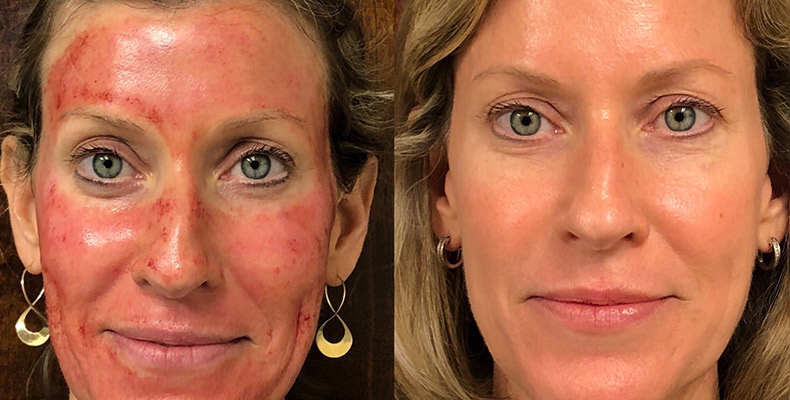Learn About the Anatomy of Your Skin
If you have never thought much about your skin, how it works, or how skin conditions develop, Columbia Skin Clinic can help you learn about the anatomy of your skin as well as how skin functions.
While some may not realize it, the skin is an organ of the human body. In fact, it is your largest organ, and the average human has about 22 square feet of skin that weighs nearly eight pounds. Skin is considered an organ due to it being a collection of specialized cells that perform a specific function. There is an entire separate anatomy of our skin.
In addition to being the largest organ, the skin is tasked with the vital job of providing a tough yet flexible line of protection, helping to keep us safe and healthy.
Skin anatomy: Layers of the skin
The anatomy of your skin is made up of three different layers. Each performs a specific function and is several layers of cells thick. The epidermis is the outermost layer of the skin, the dermis is the middle layer, and the hypodermis is the innermost layer.
Epidermis
The epidermis is what most people probably think of when they think of skin since it is the most visible layer. As a waterproof layer of cells, it keeps its internal contents protected from bacteria, viruses and any other harmful substances that might be lurking in the environment, protecting the body from infection and damage.
Breaking down skin anatomy even further, the epidermis itself is made up of five layers:
- Stratum corneum: Outer layer made up of dead cells that are replaced from epidermis layers below; this layer helps protect against UV rays, bacteria and viruses
- Stratum lucidum: A transparent layer primarily found on vulnerable areas of your hands and feet
- Stratum granulosum: A middle layer that contains keratinocytes with granules
- Stratum spinosum: Another middle layer that helps skin flexibility and is defined as “keratinocytes held together by sticky proteins”
- Stratum basale: The deepest layer that creates new skin cells and helps with the production of keratin and melanin in the body
The thickness of the epidermis varies depending on the part of the body. Some parts, like your hands, need more protection and therefore have a thicker layer than other parts.
Dermis
The dermis is not only the thickest layer of skin, but it is also arguably the most important due to its function and construction. Even with its size, the dermis only contains two layers, a top layer called the papillary dermis and a bottom layer called the reticular dermis.
With a thick, interwoven network of collagen fibers, the dermis gives your skin both the toughness it needs to stay intact as well as the flexibility needed to be able to move, bend and stretch at will. The dermis also contains other types of cells, including blood vessels and fibroblasts, sweat glands and hair follicles, making it a crucial part of the human body.
Hypodermis
Also known as subcutaneous tissue, the hypodermis layer helps connect the dermis layer to the rest of the body, regulate your body temperature, provide insulation and store energy.
The hypodermis contains adipose tissue, which helps store fat through fat-storing cells known as adipocytes. The thickness of the hypodermis will depend on hormone levels and other factors.
This layer of skin also contains blood vessels, connective tissue, hair follicles, nerves and sweat glands. By housing sweat glands, the hypodermis regulates your body temperature by releasing sweat as your body temperature increases.
The important structures of skin anatomy
The epidermis, dermis and hypodermis are not the only important parts of skin anatomy. Each layer of skin contains its own structures and components that play a vital role in how your skin and body function.
Hair follicles
While hair follicles begin and reside in the dermal layer of skin, the hair that follicles produce comes through the epidermis. Hair production is an extremely complex process that involves a combination of hormones and other chemicals for different types of hair and life stages.
Of the disorders that can be associated with hair growth, the most common is hair loss. A dermatologist can help provide different therapies and treatments to help reverse or improve hair loss.
Sensory nerves
Nerve endings give you the ability to feel sensations like temperature, texture and pain. Sensory nerve endings are located in the epidermis. These structures help supply the skin with nerves, giving you the feeling and ability to interact with the world around you.
Sensory nerves play an important role in a person’s health. Dermatologists can use these nerves during a skin biopsy to diagnose various conditions and disorders.
Sweat glands
Sweat glands, also known as sudoriferous glands, are an essential structure of the body and part of your skin’s anatomy. Without them, a person would overheat, which could lead to death. Sweat glands are located in both the dermis and hypodermis layers of the skin. They are globular structures surrounded by adipose tissue.
There are several types of sweat glands found across multiple locations in the body. For example, eccrine sweat glands are considered to be a type of small sweat gland. The average person has a total of two to four million eccrine sweat glands, with high concentrations found on the palms of the hands and soles of the feet.
Does skin anatomy affect pigmentation?
The epidermis is the skin layer that is primarily responsible for skin pigmentation. It contains a type of skin cell known as a melanocyte that produces melanin, the scientific term for the pigment that determines skin color. The more melanin produced, the darker a person’s skin color might be.
However, melanin does more than just determine skin color. It also protects the skin and the rest of the body from harmful UV rays. More melanin equals more UV protection, and sun exposure can produce more melanin as well. As a result, people with naturally darker skin are less prone to sunburn and skin cancer.
As with any bodily system or function, skin pigmentation disorders can occur, ranging from mildly noticeable to extremely dangerous. No matter the severity, a person might choose to visit a dermatologist to investigate a skin pigmentation disorder.
These disorders can include a lightening of the skin called hypo-pigmentation or a darkening of the skin called hyperpigmentation. Albinism is a total lack of pigmentation. Melasma is a dark spot that appears in a specific area of the skin.
Make an appointment with a dermatologist
The anatomy of your skin is more complex than you might think. Skin is a vital organ that needs to be cared for and protected.
Columbia Skin Clinic has locations in Columbia, Irmo, Lexington and Camden. Our board-certified dermatologists are here to help you take care of your skin, no matter the need.
If you have a skin concern, contact us today.







